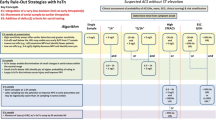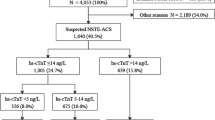Abstract
The clinical history, standard 12-lead electrocardiogram (ECG), and markers of myocardial necrosis constitute the basis for diagnosis and accurate risk assessment in patients with suspected of a non-ST-elevation acute coronary syndrome (NSTEACS). Cardiac troponin T and cardiac troponin I are ideal biochemical markers for the detection of myocardial necrosis in unstable patients who have repeated episodes of ischemia of varying intensity and several days’ duration, owing to their high sensitivity and specificity and their long duration of elevation. The troponins are independently predictive of mortality as well as of new or recurrent acute myocardial infarction after an episode of NSTEACS. By integrating the clinical history, ECG findings, and troponin results, it is possible to stratify the patients into low-, intermediate-, and high-risk groups. In addition, troponin results are useful for selecting patients who benefit from treatment with lowmolecular-weight heparin, glycoprotein IIb/IIIa antagonists, and invasive management.
Access this chapter
Tax calculation will be finalised at checkout
Purchases are for personal use only
Preview
Unable to display preview. Download preview PDF.
Similar content being viewed by others
References
Granger CB, Goldberg RJ, Dabbous O, et al. Predictors of hospital mortality in the global registry of acute coronary events. Arch Intern Med 2003;163:2345–2353.
Goldberg RJ, Currie K, White K, et al. Six-month outcomes in a multinational registry of patients hospitalized with an acute coronary syndrome (the Global Registry of Acute Coronary Events [GRACE]). Am J Cardiol 2004;93:288–293.
Bertrand ME, Simoons ML, Fox KA, et al. Management of acute coronary syndromes in patients presenting without persistent ST-segment elevation. Eur Heart J 2002;23:1809–1840.
Pettersson T, Ohlsson O, Tryding N. Increased CKMB (mass concentration) in patients without traditional evidence of acute myocardial infarction: a risk indicator of coronary death. Eur Heart J 1992;13: 1387–1392.
Ravkilde J, Horder M, Gerhardt W, et al. Diagnostic performance and prognostic value of serum troponin T in suspected acute myocardial infarction. Scand J Clin Lab Invest 1993;53:677–685.
Hamm CW, Ravkilde J, Gerhardt W, et al. The prognostic value of serum troponin T in unstable angina. N Engl J Med 1992;327:146–150.
Collinson PO, Stubbs PJ. Are troponins confusing? Heart 2003;89:1285–1287.
Alpert JS, Thygesen K, Antman E, Bassand JP. Myocardial infarction redefined—a consensus document of The Joint European Society of Cardiology/American College of Cardiology Committee for the redefinition of myocardial infarction. J Am Coll Cardiol 2000;36:959–969.
Koukkunen H, Penttila K, Kemppainen A, et al. Differences in the diagnosis of myocardial infarction by troponin T compared with clinical and epidemiologic criteria. Am J Cardiol 2001;88:727–731.
Lindahl B, Venge P, Wallentin L. Relation between troponin T and the risk of subsequent cardiac events in unstable coronary artery disease. Circulation 1996;93:1651–1657.
Antman EM, Tanasijevic MJ, Thompson B, et al. Cardiac-specific troponin I levels to predict the risk of mortality in patients with acute coronary syndromes. N Engl J Med 1996;335:1342–1349.
Lüscher MS, Thygesen K, Ravkilde J, et al. Applicability of cardiac troponin T and I for early risk stratification in unstable coronary artery disease. Circulation 1997;96:2578–2585.
Lindahl B, Diderholm E, Lagerqvist B, Venge P, Wallentin L. Mechanisms behind the prognostic value of troponin T in unstable coronary artery disease: a FRISC II substudy. J Am Coll Cardiol 2001;38:979–986.
Venge P, Lagerqvist B, Diderholm E, Lindahl B, Wallentin L. Clinical performance of three cardiac troponin assays in patients with unstable coronary artery disease (a FRISC II substudy). Am J Cardiol 2002;89:1035–1041.
James SK, Armstrong P, Barnathan E, et al. Troponin and C-reactive protein have different relations to subsequent mortality and myocardial infarction after acute coronary syndrome: a GUSTO-IV substudy. J Am Coll Cardiol 2003;41:916–924.
Morrow DA, Antman EM, Tanasijevic M, et al. Cardiac troponin I for stratification of early outcomes and the efficacy of enoxaparin in unstable angina: a TIMI-11B substudy. J Am Coll Cardiol 2000;36: 1812–1817.
Morrow DA, Cannon CP, Rifai N, et al. Ability of minor elevations of troponins I and T to predict benefit from an early invasive strategy in patients with unstable angina and non-ST elevation myocardial infarction: results from a randomized trial. JAMA 2001;286:2405–2412.
Heeschen C, Hamm CW, Goldmann B, Deu A, Langenbrink L, White HD. Troponin concentrations for stratification of patients with acute coronary syndromes in relation to therapeutic efficacy of tirofiban. PRISM Study Investigators. Platelet Receptor Inhibition in Ischemic Syndrome Management. Lancet 1999;354:1757–1762.
Kaul P, Newby LK, Fu Y, et al. Troponin T and quantitative ST-segment depression offer complementary prognostic information in the risk stratification of acute coronary syndrome patients. J Am Coll Cardiol 2003;41:371–380.
Stubbs P, Cllinson P, Moseley D, Greenwood T, Noble M. Prospective study of the role of cardiac troponin T in patients admitted with unstable angina. Br Med J 1996;313:262–264.
Jernberg T, Lindahl B. A combination of troponin T and 12-lead electrocardiography: a valuable tool for early prediction of long-term mortality in patients with chest pain without ST-segment elevation. Am Heart J 2002;144:804–810.
Hamm CW, Goldmann BU, Heeschen C, Kreymann G, Berger J, Meinertz T. Emergency room triage of patients with acute chest pain by means of rapid testing for cardiac troponin T or troponin I. N Engl J Med 1997;337:1648–1653.
Aviles RJ, Wright RS, Aviles JM, et al. Long-term prognosis of patients with clinical unstable angina pectoris without elevation of creatine kinase but with elevation of cardiac troponin I levels. Am J Cardiol 2002;90:875–878.
deFilippi CR, Tocchi M, Parmar RJ, et al. Cardiac troponin T in chest pain unit patients without ischemic electrocardiographic changes: angiographic correlates and long-term clinical outcomes. J Am Coll Cardiol 2000;35:1827–1834.
Kontos MC, Shah R, Fritz LM, et al. Implication of different cardiac troponin I levels for clinical out-comes and prognosis of acute chest pain patients. 0J Am Coll Cardiol 2004;43:958–965.
Ottani F, Galvani M, Nicolini FA, et al. Elevated cardiac troponin levels predict the risk of adverse outcome in patients with acute coronary syndromes. Am Heart J 2000;140:917–927.
Heidenreich PA, Alloggiamento T, Melsop K, McDonald KM, Go AS, Hlatky MA. The prognostic value of troponin in patients with non-ST elevation acute coronary syndromes: a meta-analysis. J Am Coll Cardiol 2001;38:478–485.
Mockel M, Stork T, Heller G Jr, et al. Troponin T in patients with low grade or atypical angina. Identification of a high risk group for short-and long-term cardiovascular events. Eur Heart J 1998;19:1802–1807.
Holmvang L, Clemmensen P, Lindahl B, et al. Quantitative analysis of the admission electrocardiogram identifies patients with unstable coronary artery disease who benefit the most from early invasive treatment. J Am Coll Cardiol 2003;41:905–915.
Antman EM, Cohen M, Bernink PJ, et al. The TIMI risk score for unstable angina/non-ST elevation MI: a method for prognostication and therapeutic decision making. JAMA 2000;284:835–842.
Lindahl B, Venge P, Wallentin L. Troponin T identifies patients with unstable coronary artery disease who benefit from long term antithrombotic protection. J Am Coll Cardiol 1997;29:43–48.
FRagmin and Fast Revascularisation during InStability in Coronary Artery Disease Investigators. Longterm low-molecular-mass heparin in unstable coronary-artery disease: FRISC II prospective randomised multicentre study. Lancet 1999;354:701–707.
Hamm CW, Heeschen C, Goldmann B, et al. Benefit of abciximab in patients with refractory unstable angina in relation to serum troponin T levels. c7E3 Fab Antiplatelet Therapy in Unstable Refractory Angina (CAPTURE) Study Investigators. N Engl J Med 1999;340:1623–1629.
Simoons ML. Effect of glycoprotein IIb/IIIa receptor blocker abciximab on outcome in patients with acute coronary syndromes without early coronary revascularisation: the GUSTO IV-ACS randomised trial. Lancet 2001;357:1915–1924.
Diderholm E, Andren B, Frostfeldt G, et al. The prognostic and therapeutic implications of increased troponin T levels and ST depression in unstable coronary artery disease: the FRISC II invasive troponin T electrocardiogram substudy. Am Heart J 2002;143:760–767.
Jernberg T, Abrahamsson P, Lindahl B, Johanson P, Wallentin L, Dellborg M. Continuous multilead ST-monitoring identifies patients with unstable coronary artery disease who benefit from extended antithrombotic treatment. Eur Heart J 2002;23:1093–1101.
Wong GC, Morrow DA, Murphy S, et al. Elevations in troponin T and I are associated with abnormal tissue level perfusion: a TACTICS-TIMI 18 substudy. Treat Angina with Aggrastat and Determine Cost of Therapy with an Invasive or Conservative Strategy-Thrombolysis in Myocardial Infarction. Circulation 2002;106:202–207.
Morrow DA. Troponins in patients with acute coronary syndromes: biologic, diagnostic, and therapeutic implications. Cardiovasc Toxicol 2001;1:105–110.
Lateef F, Storrow AB, Malone K, Liu T, Gibler BW. Comparison of a 6-hour and 9-hour protocol for evaluation of moderate-to-low risk chest pain patients in an emergency department diagnostic unit. Singapore Med J 2001;42:52–56.
Herren KR, Mackway-Jones K, Richards CR, Seneviratne CJ, France MW, Cotter L. Is it possible to exclude a diagnosis of myocardial damage within six hours of admission to an emergency department? Diagnostic cohort study. BMJ 2001;323:372–375.
James S, Armstrong P, Califf R, et al. Troponin T levels and risk of 30-day outcomes in patients with the acute coronary syndrome: prospective verification in the GUSTO-IV trial. Am J Med 2003;115:178–184.
Author information
Authors and Affiliations
Editor information
Editors and Affiliations
Rights and permissions
Copyright information
© 2006 Humana Press Inc., Totowa, NJ
About this chapter
Cite this chapter
Lindahl, B. (2006). Cardiac Troponin for Risk Assessment and Management of Non-ST-Elevation Acute Coronary Syndrome. In: Morrow, D.A. (eds) Cardiovascular Biomarkers. Contemporary Cardiology. Humana Press. https://doi.org/10.1007/978-1-59745-051-5_5
Download citation
DOI: https://doi.org/10.1007/978-1-59745-051-5_5
Publisher Name: Humana Press
Print ISBN: 978-1-58829-526-2
Online ISBN: 978-1-59745-051-5
eBook Packages: MedicineMedicine (R0)




